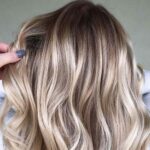
@colorbymattrez / Instagram
In This Article
Sleep on a Silk Pillowcase Avoid Drying Ingredients and Products Reassess Your Wash Day Try a Deep Conditioning Treatment Use a Microfiber Towel Avoid Excessive Heat Styling Use a Heat Protectant Apply a Leave-in Product Consider a Salon Treatment
Every shampoo commercial has one thing in common: Models with silky, ultra-smooth hair. While it’s easy to get hypnotized by the light bouncing off the shiny strands you see on TV, getting your hair to look remotely like that is not. There could be many reasons your hair isn’t as smooth as you’d like it, including lack of moisture, hormonal changes, or too much exposure to color, heat styling, sun, and chlorine, says board-certified dermatologist Iris Rubin, MD.
To figure out how to get that shampoo commercial-worthy mane, we turned to three hair experts, Rubin and hairstylists Adam Fedrerico and Aaron Grenia. Keep reading for your shiniest, silkiest hair ever.
Meet the Expert
- Adam Federico is a hairstylist and vice president of technical education for R+Co.
- Aaron Grenia is a hairstylist and the co-founder of IGK Hair Care.
- Iris Rubin, MD, is a board-certified dermatologist and co-founder of SEEN Skin & Hair Care.
01 of 09
Sleep on a Silk Pillowcase
Smooth hair starts with beauty sleep—literally. Rubin explains that hair doesn’t feel soft when the scales on the outer layer of the hair (the cuticle) don’t lie flat. “This is what causes the hair to look frizzy and dull and feel frizzy and brittle,” she says.
If you want to prevent disruption to the hair cuticle while you sleep, consider investing in a silk pillowcase. “Sleeping on a silk pillowcase can help reduce the friction that can cause frizz and breakage while you toss and turn throughout the night,” explains Rubin.
02 of 09
Avoid Drying Ingredients and Products
Depending on your hair type, certain products or ingredients could exacerbate hair dryness. “Sticking to gentle haircare products and avoiding products with potentially drying ingredients, like sulfates and ‘bad’ alcohols, can help the hair retain moisture, [leaving] it smoother and softer,” explains Rubin.
Federico adds that certain styling products, such as hairspray, can dehydrate strands, leading to second-day frizz and roughness if you do not add more moisture. He recommends using a lightweight vitamin C leave-in condition, like R+Co’s Sun Catcher Power C Boosting Leave-In Conditioner ($32), to add back moisture and smooth the mid-lengths to ends of dry hair.
03 of 09
Reassess Your Wash Day
From your shower head to the shampoo you use, you have many opportunities to add softness to your hair in the shower. That's thanks to the most important hydrating ingredient of them all: water.
“Hair can lose its soft, supple feeling for a variety of reasons. This can be anything from water quality to UV and heat damage—even humidity in the air,” says Frederico. “But ultimately, the feeling comes from a ruffled cuticle.” He says you want to smooth and seal the cuticle in the shower because a lifted or expanded cuticle feels rough. He likes using shampoos and conditioners formulated with hydrating ingredients, like R+Co’s Bel Air Smoothing Shampoo and Conditioner Set ($68).
Federico adds that you may need to look into the water you wash your hair with. Depending on where you live, you may have “hard water,” which can affect your hair’s health and texture. No matter the type of water near you, Federico says a filtered shower head may help to soften hair.
04 of 09
Try a Deep Conditioning Treatment
For smooth, soft hair, Grenia says it's all about controlling frizz. He explains that since frizzy hair types tend to be dryer, it's important to hydrate without weighing down the strands. "Look for products that [will] lock in moisture and control frizz over time," he suggests.
One way to quickly maximize moisture? Deep conditioning treatments. Grenia says that when it comes to softening hair at home, consistent moisturizing, deep conditioning treatments, and hair oiling can be very effective. Rubin agrees, adding that you can treat your hair with a restorative deep-conditioning treatment weekly for softer, smoother hair.
05 of 09
Use a Microfiber Towel
The conditioner you use in the shower works to smooth your hair, but you could be working against it with how you dry it afterward. Many people quickly (and potentially roughly) dry their hair with a traditional cotton towel, but Rubin warns that this can disrupt the hair cuticle. Instead, she recommends gently blotting excess moisture. Consider a microfiber towel that will absorb water without contributing to frizz or breakage.
06 of 09
Avoid Excessive Heat Styling
As we've learned from our experts, silky-soft hair is hydrated hair with a healthy cuticle. Heat styling tools dry out hair while disrupting the cuticle, leaving it feeling rough and brittle. For these reasons, all three experts agree: Cutting back on heat styling whenever possible is beneficial to improving the look and feel of your hair.
It’s important to note that all three of our experts say to reduce heat styling, not eliminate it. They all share the same belief that heat styling can be done without serious damage to the hair if you prepare properly and use heat protection products. Federico even says heat styling can be beneficial for sealing the cuticle, but only when done correctly.
07 of 09
Use a Heat Protectant
When you have to heat style your hair, all three of our experts say heat protectant is a must. Federico says there’s a misconception that air drying means that your hair will automatically be less frizzy when in fact, it’s heat drying that will close and smooth the cuticle—as long as it’s done with heat protection. When blow drying or heat styling, use a product that will help smooth your strands while offering heat protection, says Rubin; she recommends the SEEN Blow-Out Creme ($12).
Federico uses the R+Co Bleu Hypersonic Heat Styling Mist ($53) on his client, which he says does a fantastic job acting as a barrier between the heat and the hair. Grenia suggests the IGK Good Behavior Spirulina Protein Smoothing Spray ($34), which he compares to a keratin treatment in a can: “It smooths, adds shine, reduces frizz for up to 24 hours, and has 450°F heat protection,” he says.
08 of 09
Apply a Leave-in Product
While a significant amount of moisture is added when you wash and condition your hair in the shower, leave-in products can extend that hydration beyond wash days. There are many kinds of leave-in conditioners, each designed to provide moisture for different hair types and textures.
All our experts recommend using hair serums to lock in hydration and maximize smoothness and shine. Rubin suggests applying the SEEN Magic Serum ($36) at the end of a blow dry to boost shine and tame flyaways, then again between washes to restore softness, smoothness, and shine. Similarly, Federico uses the R+Co Bleu F-Layer Deep Conditioning Serum ($64) to prep hair for styling, telling us it can help to hydrate and repair.
09 of 09
Consider a Salon Treatment
There are many solutions for achieving smooth hair at home, but some people may benefit from an in-salon treatment (particularly if their hair is especially rough or damaged). Salon treatments are also beneficial if you’re looking to achieve silky-smooth hair quickly, as some at-home treatments require consistent use to see full results. For in-salon smoothing, Grenia recommends keratin or hair Botox treatments.
Whether you decide to up your hair's softness at home or in the salon, there are many ways to boost silk and shine. Consult your hairstylist to figure out the best smoothing strategy for your hair type and texture.
The 22 Best Anti-Frizz Products For Smooth, Silky Hair


